
Phyllanthus acidus, known as the Otaheite gooseberry, Malay gooseberry, Tahitian gooseberry, Country gooseberry, Star gooseberry, Starberry, West India gooseberry, or simply Gooseberry tree, is one of the trees with edible small yellow berries fruit in the Phyllanthaceae family. Despite its name, the plant does not resemble the gooseberry, except for the acidity of its fruits. It tastes sour and tart.

Phyllanthus emblica, also known as emblic, emblic myrobalan, myrobalan, Indian gooseberry, Malacca tree, or amla from Sanskrit amalaki is a deciduous tree of the family Phyllanthaceae. It has edible fruit, referred to by the same name.

Diselma archeri is a species of plant of the family Cupressaceae and the sole species in the genus Diselma. It is endemic to the alpine regions of Tasmania's southwest and Central Highlands, on the western coast ranges and Lake St. Clair. It is a monotypic genus restricted to high altitude rainforest and moist alpine heathland. Its distribution mirrors very closely that of other endemic Tasmanian conifers Microcachrys tetragona and Pherosphaera hookeriana.
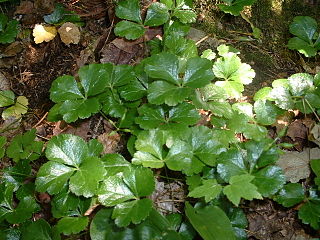
Coptis trifolia, the threeleaf goldthread or savoyane, is a perennial plant in the genus Coptis, a member of the Ranunculaceae family.
Schmitzia hiscockiana is a small, rare, red seaweed or marine alga of the phylum Rhodophyta or red algae. It was discovered and named in 1985.
The American Elm cultivar Ulmus americana 'New Harmony' was raised by the Maryland Agricultural Research Service and released by the United States National Arboretum in 1995, along with 'Valley Forge'.
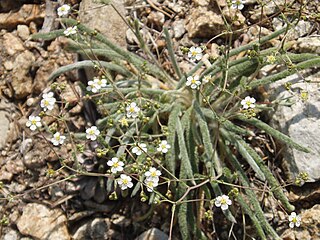
Ivesia santolinoides is a species of flowering plant in the rose family known by the common names silver mousetail, stellariopsis, Sierra mousetail and mousetail ivesia. It is endemic to California where it grows in several mountain ranges, including the Sierra Nevada and Transverse Ranges.
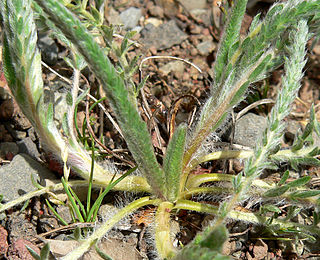
Ivesia sericoleuca is a species of flowering plant in the rose family known by the common name Plumas mousetail, or Plumas ivesia.

Phyllanthus caroliniensis, the Carolina leafflower, is a flowering plant native to the Americas, from the southeastern United States all the way to Argentina. The flowers are small and located where the leaf meets the stem.
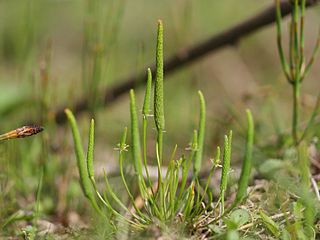
Myosurus minimus is a species of flowering plant in the buttercup family known by the common name tiny mousetail or just mousetail. It is native to much of the Northern Hemisphere, including parts of Europe, Asia, North Africa, and North America. It generally grows in moist habitat types, such as riverbanks and wet meadows. It is an annual plant forming a small tuft up to about 12 centimeters tall. The leaves are linear and narrow, sometimes threadlike, and up to 6 centimeters in length. The inflorescence produces a single flower which has an elongated, cylindrical or cone-shaped receptacle up to 4 centimeters long. At the base of the receptacle are curving, spurred sepals, five petals up to 3 millimeters long, and 10 stamens.

Clerodendrum tomentosum, known as the downy chance, hairy lolly bush, hairy clairy or hairy clerodendrum is a shrub or small tree occurring in eastern and northern Australia. Distributed from Batemans Bay in southern coastal New South Wales, Queensland, Northern Territory, Western Australia, and New Guinea.

Phyllanthus microcladus is a plant found in sub tropical areas of eastern Australia. The brush sauropus is listed as endangered by extinction. It occurs by streams in sub tropical rainforest, from as far south as Grafton, New South Wales to the south east rainforest areas of Queensland. Most often seen in the valleys of the Brunswick, Richmond and Tweed Rivers in far north eastern New South Wales.

Phyllanthus pulcher, the tropical leaf-flower, is a species in the genus Phyllanthus. Phyllanthus pulcher is known commonly as a weed. Its leaves fold closed at night.
The Hillbilly Tomato, also known as the "hillbilly potato leaf tomato", scientific name Solanum lycopersicum, is an heirloom cultivar originating from West Virginia in the 1800s. This fruit is considered a beefsteak tomato weighing 1-2 pounds. It is round, heavily ribbed and its skin and flesh is orange- yellow with red streaks. The flavor is described "sweet and fruity" and is low in acid.
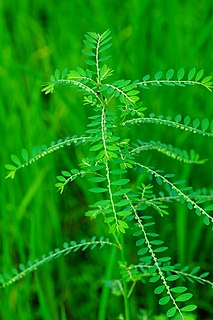
Phyllanthus niruri is a widespread tropical plant commonly found in coastal areas, known by the common names gale of the wind, stonebreaker or seed-under-leaf. It is a relative of the spurges, belonging to the genus Phyllanthus of the family Phyllanthaceae.
Niebla juncosa is a fruticose lichen that grows on rock, stony soil and sand along the Pacific Coast of Baja California from Punta Banda to Morro Santo Dominogo. The epithet, juncosa is in reference to the thallus divided into rush-like branches, the stems of the flowering plant genus Juncus.
Phyllanthus abnormis, known as Drummond's leafflower, is an herbaceous plant in the family Phyllanthaceae. It grows from 10 to 50 centimeters in height. It is native to the United States and Mexico (Tamaulipas). Throughout its range, it is always found growing in sand or sandy soil.
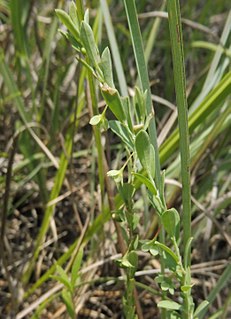
Phyllanthus polygonoides, known as smartweed leaf-flower or knotweed leafflower, is an herbaceous perennial plant in the family Phyllanthaceae. It grows from 10 to 50 centimeters in height. It is native to the United States and northern and central Mexico.
















